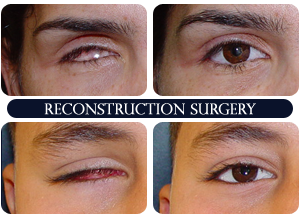Unfortunately, over time an upper eyelid and /or lower eyelid may become "droopy" or "baggy" because the eyelid skin stretches, muscles weaken, and fat pockets bulge and become more prominent around the eyes. This most commonly occurs because of the aging process but also may be due to a hereditary condition that runs in your family. Your eyebrow also may sag or droop as part of this same process.
Aesthetically, such conditions may detract from the overall attractiveness of one's eyes and cause a "tired" or older appearance. When severe, these conditions also may cause functional problems, such as impaired field of vision (baggy upper eyelid) or difficulty wearing glasses (baggy lower eyelid).
Eyelid surgery to improve the appearance of the eyelids is termed "blepharoplasty" or "eyelid lift surgery." Blepharoplasty surgery is usually an outpatient procedure performed under local anesthesia, with sedation if desired.



The goal of this eyelid surgery is to reduce the "baggy" or sagging tissues, which may include skin, muscle, and fat pockets. In upper eyelid surgery, typically all three types of tissue are removed. In lower eyelid surgery, sometimes only the fat pockets need to be removed, or the skin and muscle also may need to be included.
During eyelid surgery, incisions are made in the natural folds of the eyelid so that they are virtually unnoticeable after the tissues have healed. After the excess tissue is removed, the incisions are closed with fine sutures.
If only fatty tissue needs to be removed from the lower eyelid, and not any skin, the surgery can be performed behind the eyelid. This surgery is known as "transconjunctival blepharoplasty" and leaves no visible scar.
In cases where the eyebrows are also droopy, a procedure to elevate the eyebrows may be appropriate. This procedure, known as a brow or forehead lift, may be done directly above the eyebrows, within the forehead creases, or by approaching the brows from the hairline or just behind the hairline as a "coronal brow lift" or "endoscopic brow lift."
 |
 |
|
| Blepharoplasty Preparation | Ptosis Surgery |
Following eyelid surgery, cold compresses are applied to the eyelids to reduce swelling and bruising. These are later followed by warm compresses to improve blood flow to the area and aid in the healing. The eyes do not need to be patched shut. During the first week, antibiotic ointment is applied to the eyelids, and strenuous activity should be minimized.
Discomfort is usually minimal after eyelid surgery. Aspirin products and "blood thinners" should be avoided before and after surgery because of their tendency to increase bruising.
After eyelid surgery, one may temporarily experience minor discomfort, tightness of an eyelid, swelling, bruising, and dryness of the eyes. These will usually resolve as the wounds heal. Excessive pain, bleeding, infection, or loss of vision in the period following eyelid surgery are very rare. In the unlikely event that such a problem occur, you should notify your physician promptly.
Complications that may occur include slight asymmetry in eyelid appearance or eyelid position. These problems occur infrequently and may require additional surgery to correct.
Blepharoplasty surgery can provide both cosmetic and functional improvement with minimal risk of serious problems. Most patients are quite pleased with the results of their eyelid surgery.







